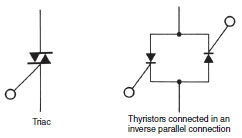What is the difference between triacs and thyristors?
They are essentially the same in terms of resistive loads. For inductive loads, however, back-to-back thyristors are effective.
Thyristors connected back-to-back or a triac can be used for Solid-state Relay switching elements.
Thyristors and the triacs differ in their characteristics to enable the elements to adjust to a rapid rise or fall.
These characteristics are expressed as dv/dt (unit: V/ μs). The dv/dt value for thyristors is greater than the value for triacs.
Triacs help downsize Solid-state Relays because they can sufficiently perform switching for motors of up to the 3.7-kW class with inductive loads, and one triac element provides functionality equivalent to two thyristors connected back-to-back.
Note: dv/dt is the rate of voltage rise.
| Resistive load | Inductive load | |||
| 40 A max. | Over 40 A | 3.7 kW max. | Over 3.7 kW | |
| Triac | OK | OK | OK | Not as good |
| Two thyristors | OK | OK | OK | OK |